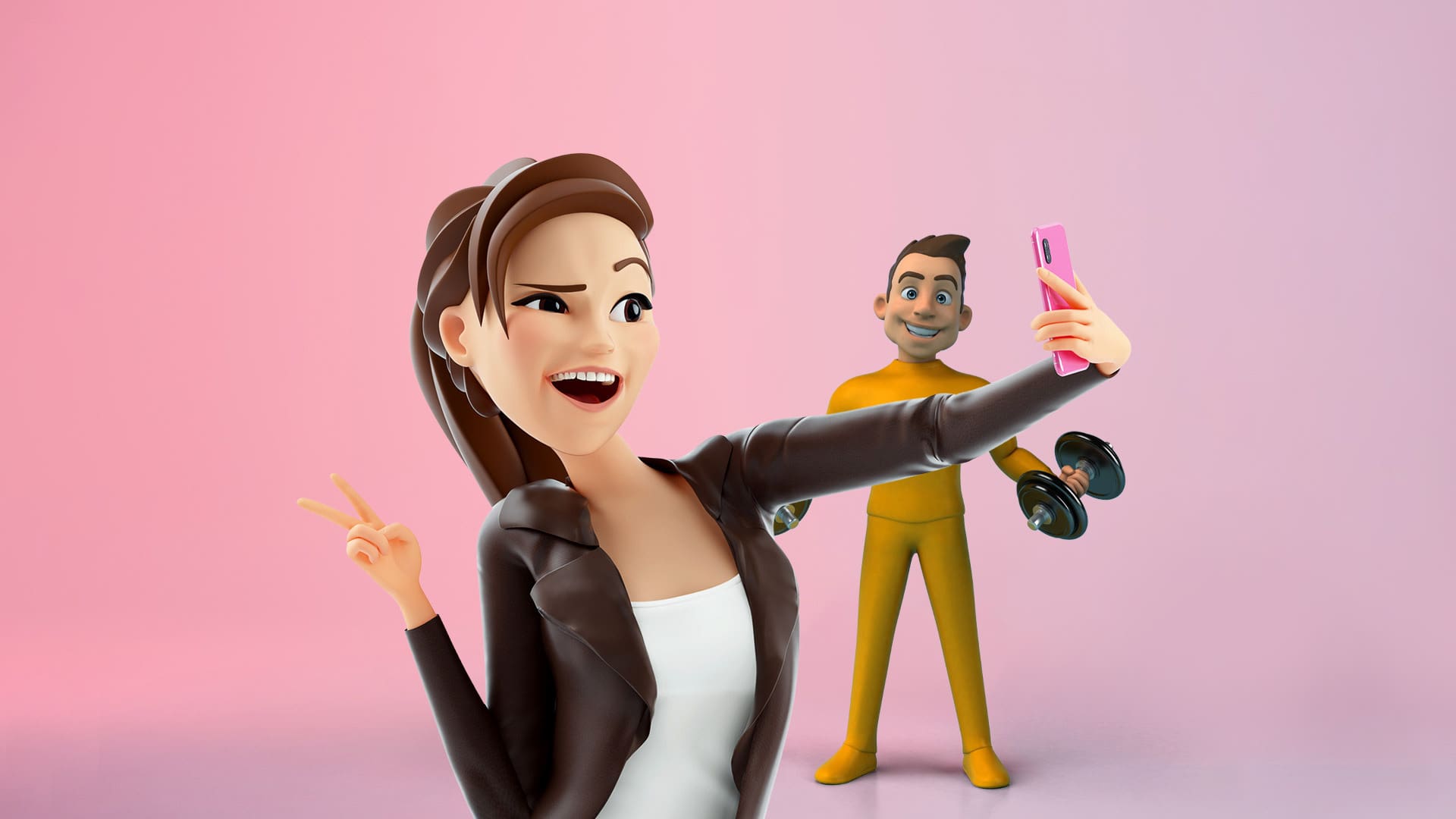In recent years you may have come across the term virtual influencers. Perhaps you have even come across one online yourself. Representing the latest evolution in the growing field of influencer marketing, why do these fictional characters appeal to so many? In this blog, we examine the route of their power, how we got here, the benefits they offer brands and whether virtual influencers are here to stay.
The Power of Our Peers
For those reading this blog on a mobile device, statistically, there is an excellent chance you are doing so on an iPhone. Even though models have changed, had we asked the question a decade ago, the answer would likely be the same.
It is perhaps something to which you have never given a great deal of thought. After all, whether it’s a tech brand like Apple or a sports brand like Nike, there are some companies we love and others we don’t. But is it that simple? And why do so many of us find ourselves drawn to the same brands time and time again?
It’s a complex question to answer, as, in reality, many factors influence our behaviour as consumers. Moreover, many of these have changed over time, with tech creating countless new marketing tactics for brands to explore.
Luckily, this blog is destined to focus on just one factor: the undeniable and well-proven influence that has never changed…. our peer group. Swaying our opinion on everything, it’s often those we love, those who make us laugh, those who inspire us and those we admire from afar who exercise the most control. For example, did you know…
81% of people say friends on social media influence their buying behaviour.
The Golden Age of Brand Endorsements
Strategic endorsements have long been the favoured method for brands seeking to replicate this feeling amongst the masses. Their popularity and power are why most actors’ and sports stars’ wealth now comes outside of the professions that initially gained them notoriety.
Think about Steph Curry and Under Armour, George Clooney and Nespresso, or George Foreman and Salton Electric Grills. That deal alone is reported to have earned the former heavyweight world champion over $200million!
The underlying logic of these eye-watering sums lies in the influence of our peers. And, as we alluded to before, this is no longer regarded as simply a close circle of friends. So what happens when we find ourselves attracted to a brand? Perhaps it’s their product, message, values, or personality. They can resonate with us on an intrinsically appealing level, with a view of the world not too dissimilar to our own.
However, like in any relationship, nobody wants to get hurt. So, you ask yourself whether you trust them or if they will ultimately let you down. As a result, celebrity endorsements carried a lot of weight and continue to do so with the right audience. They are friendly faces and people we trust, giving us as consumers the confidence to take the plunge. Their positive image and personality traits help validate the brand messages we want to believe and provide a considerable level of social currency.
For those with pockets deep enough to make celebrities the face of their brand, it is a huge advantage. It’s the difference between having a friend introduce you to a new group of people at dinner and walking up to someone who looks like fun and simply sitting down.
Influencers Spoil the Party
So, what about these smaller brands? As we noted in the last paragraph, there are few with capital, let alone a global presence, that could fulfill the impact of such a powerful celebrity endorsement. Well, in recent years, this is where the new bread of influencers has stepped in.
From YouTubers to bloggers and TV personalities, their influence and strength of relationship with niche groups of the population have proved a perfect match for smaller brands. More affordable and highly targeted, the close bond influencers have with their followers means smaller brands can be sure their message is not only getting through but is being told with the voice of an authentic and relatable peer on a social platform where interaction and conversation drive brand visibility.
Take a brand such as Gym Shark as a prime example to illustrate the power of influencer marketing. Growing at an unprecedented rate, it’s a young brand with no business in a concentrated sportswear market full of established MNCs. But 10 years since launch and they have more than achieved it.
While Adidas may have a lifetime deal with David Beckham worth $160million, Gymshark draws on a roster of much smaller influencer partnerships. Each represents a slightly different demographic and allows the brand to speak with a range of unique audiences.
Benefiting from the direct dialogue and relationship the influencer has with its community, they appeal to people who the singular voice of a celebrity might put off. A growing strategy no longer limited to smaller brands, it has convinced many to take a plunge on young start-ups like Gym Shark and never look back.
Reportedly brands will spend as much as $ 15 billion on influencer marketing in 2022.
Its a Strategy Not Without its Flaws
So, are there any risks for a brand seeking to make influencers the centrepiece of their marketing efforts? As is true for both celebrity endorsements and influencer marketing, a large proportion of the associated risk comes from choosing to entrust the control of your message to the hands of another. Remember, with great power comes great responsibility control.
As we have highlighted, much of an influencer’s power comes from that person’s personality, image, positive sentiment, and audience relationship. Although not so strongly connected with followers, celebrity endorsements offer the same and are seen as a safe pair of hands. Relinquishing a bit of control in a safe studio environment, campaigns can be shot with an established face that is polished and unlikely to act or behave in a way that could bring any negative publicity.
However, this is where influencers have proven more complicated, and it’s hard to get away from. After all, their appeal lies in authenticity and an organic format that allows their personalities to shine. For brands, these partnerships hand over much more control, from shooting content to the delivery of their message.
What is also of concern is the impact that both small and big mistakes offline can have on an influencer. Blurring the lines between the virtual and real world, in recent years, there have been countless examples of even the most respected influencers losing the following they so quickly amassed. An element out of a brand’s control, the impact of negative associations and perceptions will last longer than positive ones.
Virtual Influencers Step into the Arena
Circling back to our original question, it’s clear that celebrity endorsements and now influencers have built on the knowledge of how our peers impact us. Their role in pop culture and consumer trends is seismic and works as a fantastic facilitator for brands looking to introduce themselves.
So as we move forward and the use of micro and macro influencers grows, what’s next? Can their influence increase further, and how can the above mentioned issues be addressed? Well, several brands are now turning to so-called ‘virtual influencers’.
So, just what is a Virtual Influencer?
Also known as AI influencers, this growing group of fictional characters lead a life online that mirrors many of our own. Carefully developed and designed by expansive creative teams, they have a personality, a voice, interests, relationships, and emit emotions just like us (even without a beating heart).
Computer generated with an appearance that resembles a Sims character, the technology at play here means the possibilities they present know no bounds. Completely scripted and freed from the restraints of reality, what they can achieve in their lives is only limited by imagination. Should a character grow alongside its audience or remain frozen in time in a fashion similar to animated TV shows for new generations to discover? The choice is in your hands.
How Are Brands Using Them?
If you have heard of any AI influencers, it is likely to have been Lil Miquela. Attracting 3 million Instagram followers, she has found herself at the centre of most discussions and media attention on the topic. Created by technology company Brud, you will find similar enterprises behind many of the most notable virtual influencers.
Fulfilling brand partnerships like any other, Lil Miquela has worked with several international fashion brands, such as Calvin Klein. More recently, she was one of several influencers to front Samsung’s #TeamGalaxy Campaign.
But why pay to use someone else’s virtual influencer when you could create your own? That is certainly the conclusion car manufacturer Reanult came to. They chose to debut their own virtual ambassador, Liv, in one of their recent Kadjar adverts.
Prada is another such brand that has gone full in on AI influencers. However, they have experimented with well-known figures such as Lil Miquela at Milan Fashion Week. And also, their creation, Candy, who promoted one of their latest collections in 2021.
So What Does all this Mean for the future?
Adopting the latest technology is essential for brands to be relevant and current amongst a younger demographic. Particularly in highly competitive B2C markets such as fashion and gaming. AI influencers no doubt open more doors in this regard, as YouTube influencers and celebrity endorsement deals have done previously.
It is without question the next evolution of the peer-to-peer influence that we highlighted at the start of this blog. And the popularity of Lil Miquela, alongside others such as Lu do Magalu and Knox Frost, suggests an appetite for watching, listening and interacting, real or otherwise.
From the POV of a brand, it is an opportunity to overcome the control obstacles they face with real-life influencers. Taking back complete control of their message and the person disseminating it. After all, it can be challenging for a brand to find an influencer that embodies their personality perfectly. Hence, why not create one? Imagine GoPro created a pro surfer or snowboarder like Lil Miquela and engineered its personality to represent their brand perfectly. It’s something that either excites you or terrifies you.
However, it’s also important to acknowledge that people love and admire influencers, in part, because they represent a lifestyle that feels more familiar. This is the line that virtual influencers and their creators must walk. Although they could be in Paris one day and Los Angeles the next, feeling too scripted and more like a fairytale has the potential to be their downfall.
Offering a blemish-free and fully controllable canvas to work with, the appeal of virtual influencers isn’t rocket science. However, as we move into a world where AI is destined to play a much more significant role in everyday life, only time will tell whether they represent the next big thing, or prove to be a step too far.

